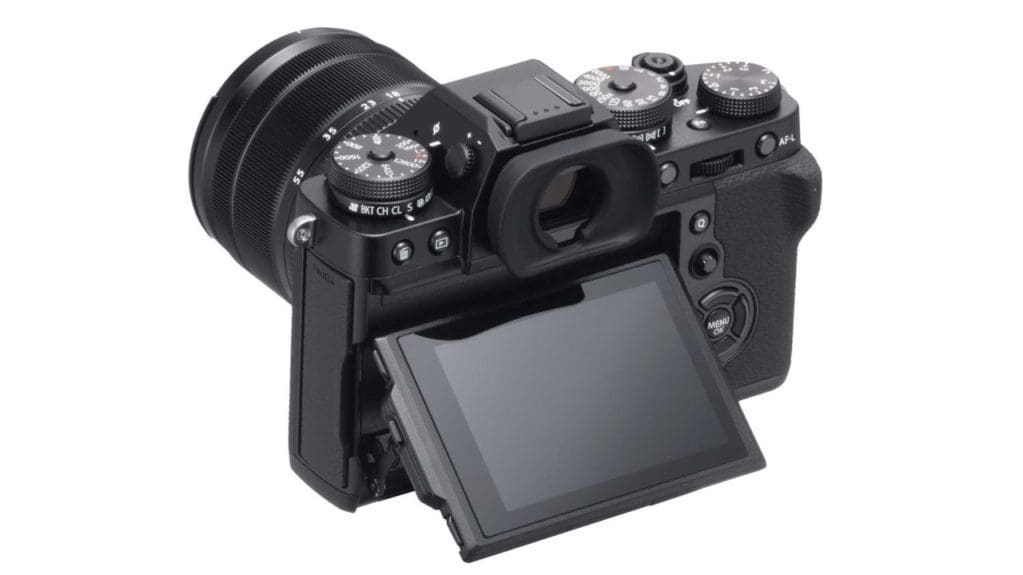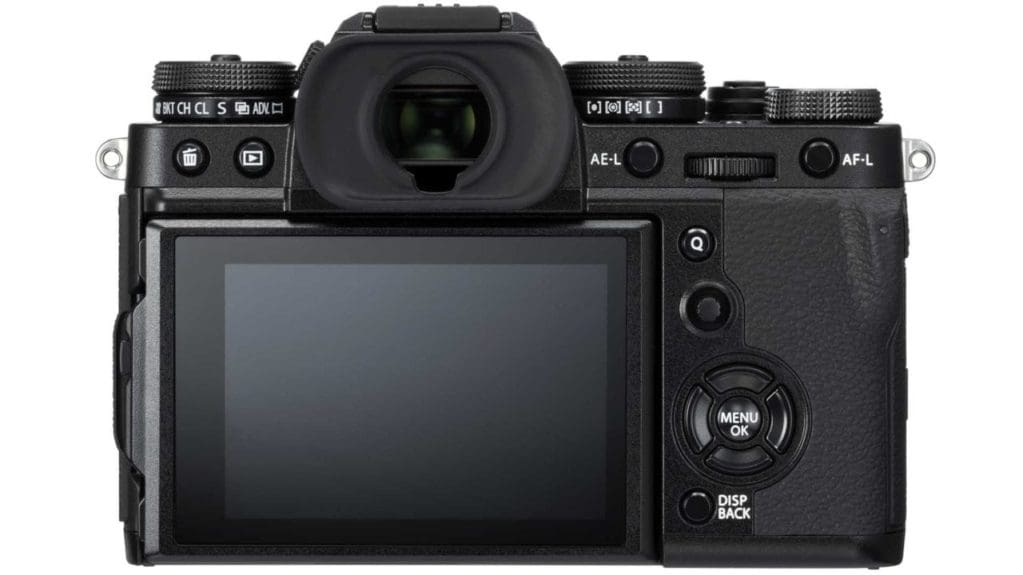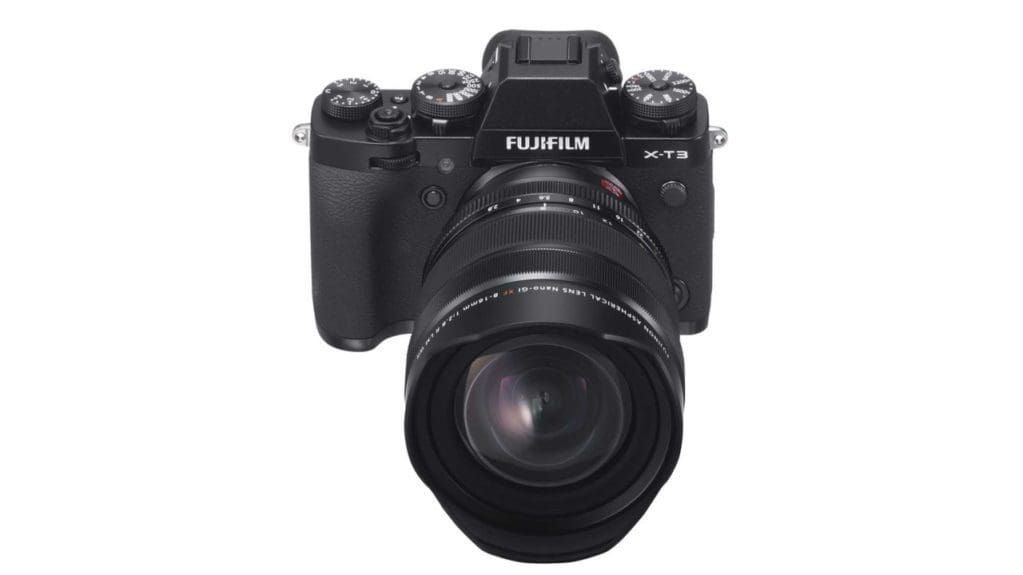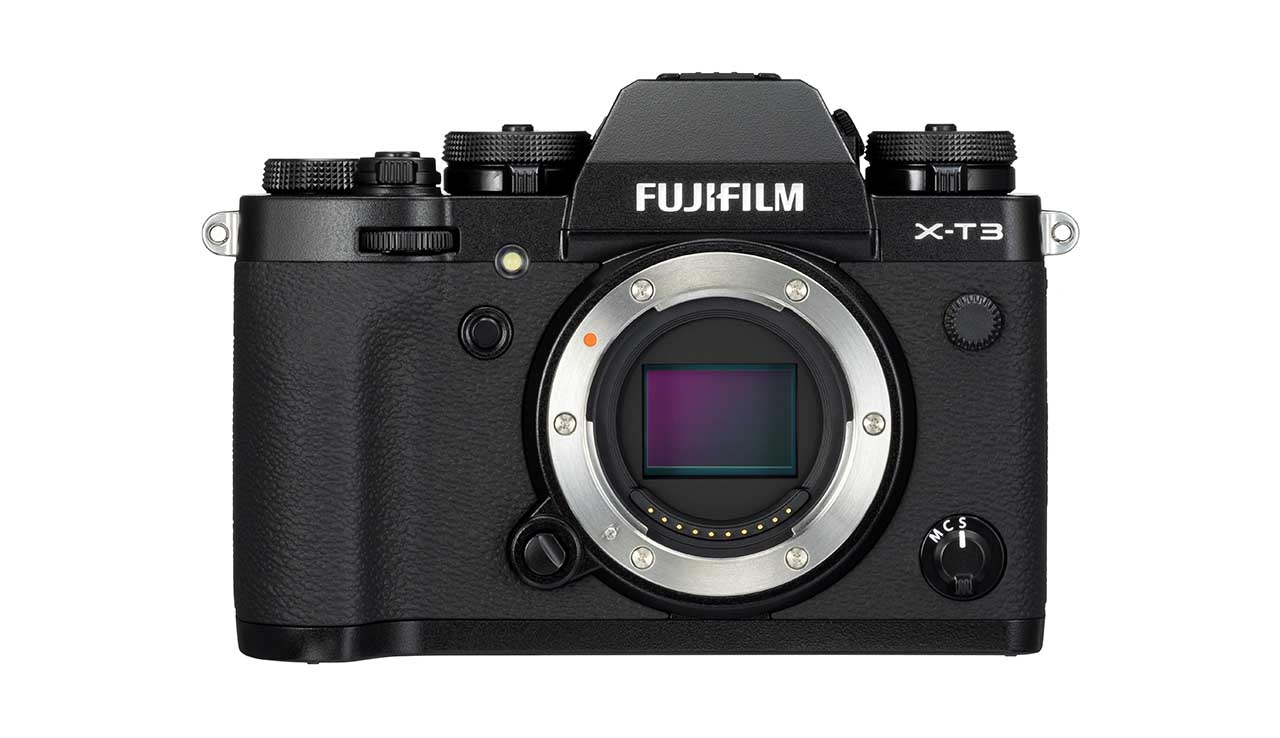Fujifilm has announced the new flagship X-T3 – price tag starting at £1,349/$1,499 – which boasts a new sensor, video enhancements and AF improvements, with a release date set for 20 September.
Inside the Fuji X-T3 is a newly developed back-illuminated 26-megapixel X-Trans CMOS 4 sensor that boasts more than four times the number of phase detection pixels than the X-T2 and X-H1. That means there’s a significant step-up with the autofocus system.
With the new sensor, the X-T3 offers a lowest native sensitivity of ISO 160, and low-light autofocus has been extended to -3EV. Previous Fujifilm X-series cameras have a base of ISO 200.
Also on board is the new X Processor 4. This new processing engine has 4 CPU units and is about three times faster than the processing engine in the X-T2 and X-H1.

Fujifilm says this boost the X-T3’s AF speed as well as accuracy and helps the camera deliver the world’s first 4K/60p 10-bit output in a mirrorless camera equipped with an APS-C size sensor or larger.
AF speed is said to be 1.5 times faster than the X-T2 and X-H1, and Fujifilm says it has ‘substantially enhanced’ the performance of face and eye detection AF thanks to 2.16m phase detection pixels across the entire frame.
What’s more, Fujifilm says the X-T3 AF system can better track fast-moving subjects. And when the camera is in its electronic shutter mode, it can deliver blackout-free continuous shooting of up to 30fps while using Live View of 60fps to check your subject.
Good news for wedding photographers, the Eye AF is now said to work with continuous autofocusing.
There’s also a new “Pre-Shoot” function that sets the X-T3 to begin shooting as soon as the shutter release is pressed halfway. It should cut down the number of missed shots when you’re waiting for something unpredictable to happen.
Continuous shooting
The X-T3 can shoot at up to 11 fps with the mechanical shutter or 20fps with the electronic shutter. And in a change from the X-T2, it doesn’t require the battery grip to achieve those rates.
There’s also a new “Sports finder mode” that enables you to capture 16.6M (1.25x crop) images from an area marked in the viewfinder/LCD. When this mode is used with the electronic shutter, it’s possible to shoot at up to 30fps.

Viewfinder and Screen
Fujifilm has given the X-T3’s 0.5-inch OLED electronic viewfinder a significant resolution boost in comparison with the X-T2’s. There are 3.69 million dots putting it level with the viewfinder in the Sony A9.
Further good news is that the 100 fps ‘boost mode’ refresh rate is possible without the optional battery grip.
Meanwhile, the 3.0-inch 3:2 dual-tilting screen has 1.04 million dots, which is the same as the X-T2. However, it’s touch-sensitive.

Video
As mentioned previously, the X-T3 can record 4K/60p video. When output to an external recorder it can be saved in 10-bit 4:2:2 while internal recording is 10-bit 4:2:0 internally with the H.265 codec. F-Log recording is also possible and HLG support will be coming later in the year.
According to Fujifilm, rolling shutter effect has been reduced by the sensor’s faster readout rate.
The camera body has both mic and headphone sockets built-in. There are also HDMI and USB-C ports and the cover is removable to make it easier to use the X-T3 with a cage.

Fuji X-T3 Price and Release Date
The Fujifilm X-T3 has a body-only price of £1,349/$1,499. It’s set to retail for $1,899 with the 18-55mm lens.
It will go on sale on 20 September.
Specifications
[table id=83 /]
Press Release
FUJIFILM Corporation (President: Kenji Sukeno) has announced that it will release the FUJIFILM X-T3 (hereinafter “X-T3”), the latest model in the X Series of mirrorless digital cameras, renowned for their unique colour reproduction technology to deliver outstanding image quality in both stills and video.
The X Series began with the 2011 release of X100. The X-Pro1, released in 2012, became the first model to feature the X-Trans CMOS sensor, which uses a unique colour filter array based on FUJIFILM’s extensive photographic expertise to achieve exceptional image-resolving performance and control of false colours at the same time, as well as the EXR Professor Pro image processing engine compatible with the sensor. For seven years, the X Series and its sensor – image processing engine combination have continued to evolve, with the company unveiling “X-Trans CMOS II” / “EXR Processor Pro II” in the X-T1, released in 2014, and “X-Trans CMOS III” / “X-Processor Pro” in the X-Pro2 and X-T2, released in 2016. The three generations of evolution have constantly advanced the X Series’ image quality and mobility.
The latest model, X-T3, features the new X-Trans CMOS 4 sensor and X-Processor 4 image processing engine, ushering in a new, fourth generation of the X Series.
New devices
X-Trans CMOS 4: This is the back-illuminated APS-C sensor with more than 4 times the number of phase detection pixels than current models (*3), distributed across the surface. It boasts a high S/N ratio and the lowest sensitivity of ISO160 despite its 26MP resolution. The low-light autofocus limit has also been extended to -3EV, enabling accurate AF even in low light conditions, e.g. scene lit only with candlelight.
X Processor 4: This engine has 4 CPU units to achieve image processing speed about 3 times faster than that of current models (*3). Not only boosting AF accuracy and speed substantially, the engine is the world’s first (*2) to delivers 4K/60P 10bit output, meeting the needs of professional videographers, in a mirrorless camera equipped with a sensor in the APS-C size or larger. It is also capable of instantaneously handling complex image processing tasks such as FUJIFILM’s unique “Colour Chrome Effect” and “Monochrome Adjustment” function, achieving Warm Black / Cool Black tone in digital, which is adopted as one of the way of expression for monochrome print in silver halide film.
The X-T3 takes full advantage of the capability of these fourth-generation devices to enjoy significant performance improvement.
Higher image quality: Highest level of 26.1MP resolution in APS-C size sensor. Also, it achieves keeps as low level of noise as current models (*3) even increasing the number of pixels.
Dramatically improved AF performance: 1.5 times faster processing speed than current models (*3) to deliver faster and more accurate AF, and substantially enhanced performance in face / eye detection AF thanks to 2.16M phase detection pixels arrayed at entire frame.
Significant improvement in tracking performance of fast-moving subject: Delivering blackout-free continuous shooting (*4) of up to 30 fps while using smooth Live View of 60fps to check your subject.
Video performance for professionals: Supporting 4K/60P 4:2:0 10bit internal SD card recording as well as 4K/60P 4:2:2 10bit HDMI output, which can be filmed at the same time. Also, featuring the video-specialized Film Simulation mode “ETERNA,” popular with the X-H1.*1 X-TransTM is FUJIFILM Corporation’s trademark or registered trademark. The sensor has a unique non-periodic filter array to reduce the appearance of moire patterns and false colours without the use of an optical low-pass filter.
*2 As of September 6, 2018, according to FUJIFILM data
*3 Comparison with current models “FUJIFILM X-T2” and “FUJIFILM X-H1”
*4 Available only when using the electronic shutterMain Features
Use of the Series’ fourth-generation devices, new sensor “X-Trans CMOS 4” and new processor “X-Processor 4,” for the highest image resolving performance, colour reproducibility and fastest processing in the history of the X Series
1) The X-T3 features the X Series’ fourth-generation APS-C sensor, newly developed “X-Trans CMOS 4” (26.1MP, without low-pass filter). It uses the unique colour filter array synonymous to X-Trans CMOS sensors to control moire and false colours and adopts the Series’ first back-illuminated structure to improve image resolution without compromising the S/N ratio. Furthermore, the sensitivity of ISO160, previously available only as extended ISO, is now part of the normal ISO range. It is very useful in daylight outdoor shooting or when trying to achieve bokeh with a fast large-aperture lens.
2) The X-T3 uses the new “X-Processor 4” image processing engine to add the new “monochrome adjustment” function to the Film Simulation modes, which are based on FUJIFILM’s proprietary technology to deliver diverse colour expressions. Warm black and cool black, conventionally achieved with a choice of specific photographic papers and developers, have been faithfully reproduced digitally to broaden the scope of monochrome expressions. This function is available in the standard “Monochrome” mode as well as the “ACROS” mode, which provides smooth halftones, deep blacks and beautiful textures.
3) The “Colour Chrome Effect,” previously only available in FUJIFILM’s medium-format mirrorless digital camera “GFX50S,” is featured in the X-T3, the first in the X Series. The effect produces deeper colours and gradation in subjects with highly saturated colours, such as vivid-coloured flowers with shadows, a notoriously difficult photo subject for gradation reproduction. The high-speed processing power of the X-Processor 4 means this effect can be applied not only in single shots but also in continuous shooting.
Use of the new devices and improved algorithm for significant improvement in AF performance in low light and when tracking a moving subject
1) The X-Trans CMOS 4 has 2.16M phase detection pixels, more than 4 times compared to current models (*3), increasing the phase detection AF area to entire frame (approx. 100%). Fast and accurate phase detection AF can be used even on a subject that is positioned away from the centre of the frame. The low-light phase detection autofocus limit has also been extended by around 2 stops from -1EV to -3EV, making it possible to accurately focus in low light conditions, e.g. a scene lit only with candlelight, or night-time photography. Furthermore, the X-Processor 4’s high processing speed and improved phase detection algorithm means the camera refocuses (AF) and meters (AE) 1.5 times more frequently than current models (*3) to enable accurate autofocus even when shooting sports involving fast and erratic movements across the frame.
2) The performance of face-detection AF on a moving person has been doubled over current models (*3). The eye-detection AF supports the AF-C mode, maintaining accurate focus tracking even in portrait photography that involves movements. The X-T3 focuses accurately when shooting a person front-on or side-on, even in situations where the face- or eye-detection AF previously had difficulty. The face- and eye-detection AF is available also during video recording to achieve smooth filming of persons.
Enhanced viewfinder performance improving the ability to track a moving subject
1) The X-T3 features a 3.69-million-dot high resolution EVF with a high magnification ratio of 0.75x. The display time lag of just 0.005 seconds and refresh rate of approx. 100 fps ensure smooth display of motions, allowing you to precisely identify subject movements and focus positions. Unlike current models (*3), continuous shooting of 11 fps with the mechanical shutter no longer requires the optional vertical grip, enabling fast continuous shooting while keeping the camera weight low.
2) The new “Sports finder mode” makes it easy to capture a moving subject. The mode shows approx. 16.6M (1.25x crop) area marking in the LCD/viewfinder, and shoots the area within the marking. This is particularly useful for sports photography and wildlife photography, as you can check the movements of a subject just outside the shooting frame and take advantage of shorter-than-usual blackout time.3) Increased read speed from the sensor and high-speed processing capability have made it possible to enjoy AF/AE-tracking, blackout-free continuous shooting(*4) of up to 30 fps in approx. 16.6M (1.25x crop) mode, while using smooth Live View of 60fps to check your subject. The rolling shutter distortion, a typical issue of electronic shutters, has been halved compared to current (*3) models.
In order to never miss a crucial shutter moment, the X-T3 has the new “Pre-Shoot” function (*4), in which the camera starts shooting as soon as the shutter button is half-pressed. You will never miss an important photo opportunity, previously caused by time lag between the moment when the shutter button is fully pressed and the moment when a photo is actually taken.
Design / operability and expandability
1) The X-T3 inherits X-T2’s popular design features such as the positioning of dials on the top panel, central viewfinder style for added sense of stability, and excellent grip design for comfort. The silver color is lineup as standard, which features more classical tone compared with graphite silver, limited edition for previous models. Its styling that reminds you of traditional film cameras is combined with outstanding practicality, making it photographic equipment that is a pleasure to own for many years to come.
2) Enhanced operability and expandability in response to user feedback
Specific areas of operability enhancement
・EVF’s diopter adjustment is lockable achieved by pulling out and rotating a diopter knob, so as to prevent unintended adjustments while carrying the camera.
・The X-T3 uses a touchscreen panel with higher contrast, wider viewing angle and better operability than those in previous models to enable intuitive operation.
・The X-T3 inherits X-H1’s features such as large top-panel dials / rear-panel buttons and comfortable clicking touch of front and rear command dials.
・A headphone jack is provided on the camera body so that all accessories required for video recording, such as microphone and HDMI devices can be centrally connected to the body for added mobility in videography.
・Terminal cover is removable, providing easy connectivity for HDMI cables, microphones, headphones. Also it will not disturb when setting up with rig for movie shooting.
・The USB terminal supports USB Type-C (USB3.1 Gen1) specifications. An Anker (*5) battery can be connected to significantly increase the maximum number of frames per charge and the maximum duration of video recording.Enhanced video performance
1) This is the world’s first (*2) mirrorless digital camera capable of internal SD card recording 4K/60P 4:2:0 10bit. It is also the world’s first (*2) mirrorless digital camera with APS-C or larger sensor capable of 4K/60P 4:2:2 10bit HDMI output. Supported video formats include the widely-used H.264/MPEG-4 AVC as well as H.265/HEVC for greater data compression. This enables the use of high 200Mbps bitrate in recording of 4K/60P 4:2:0 10bit, as well as simultaneous HDMI output while recording. Video compression options available are ALL-Intra (*6) and Long GOP. When using ALL-Intra, video is recorded at 400Mbps (*7).
2) The sensor’s read speed is about 50% faster than current models (*3), which enables fast 17msec reading of 4K/60P video. The rolling shutter distortion has been reduced for smooth replay of a fast-moving subject. The camera’s support for 10bit colour depth boosts the amount of colour information 64 times compared to 8bit. This is combined with 400% (approx. 12 stops) dynamic range for capturing materials of rich gradation, such as a sunset landscape.
3) The introduction of a new noise reduction process and new “4K interframe noise reduction” function have reduced noise by the equivalent of approx. 2 stops. The new NR process has an enhanced level of noise-identifying accuracy for appropriate reduction in noise. The 4K interframe NR function (*7) uses differential data between adjacent frames to reduce noise. Furthermore, the minimum sensitivity for shooting F-Log and DR400% footage has been extended from the current models’ (*3) ISO800 to ISO640, meeting the needs of videographers.
4) In addition to the abovementioned functions, the X-T3 will, after applying a firmware update to be released by the end of 2018, support video recording in the Hybrid Log Gamma (HLG), one of the formats defined in the ITU-R BT.2100 international standards. In response to user feedback, the firmware update is also due to give the X-T3 an ability to simultaneously output Film Simulation and F-Log footage.
*5 Anker is trademark or registered trademark of Anker Innovations Limited or associated companies.
*6 Available at 4K/29.97P, 25P, 24P, 23.98P, and FHD/59.94P, 50P, 29.97P, 25P, 24P, 23.98P when H.265/HEVC is selected.
Not compatible with H.264.
*7 Available at 4K/29.97P, 25P, 24P or 23.98P.
Requires an SD card with the video speed class of V60 or above to record at the bitrate of 400MbpsOptional accessories
1) Vertical Battery Grip VG-XT3 (designed specifically for the X-T3)
This grip is dust-resistant, water-resistant and capable of operating at temperatures as low as -10°C. It fits two batteries, bringing the total number of batteries to three, including the one on the camera body, to increase the maximum number of frames that can be taken per charge to approx. 1,100 (Normal mode). The camera does not need to suspend its operation to switch to a new battery, even during continuous shooting or video recording, providing a stress-free shooting experience.
The grip features the shutter release button, focus lever, AE-L button, AF-L button, command dials, Q button and Fn button to provide the same level of excellent operability in vertical shooting as you get in horizontal operation. The VG-XT3 itself has battery-charging functionality. Using the AC adapter supplied (AC-9VS), you can fully charge two batteries at the same time in approx. 2 hours.2) Leather Case BLC-XT3 (designed specifically for the X-T3)
This is a genuine leather bottom case with luxurious textures. The camera can stay in the case while the battery is replaced. The case comes with a cloth to wrap the camera in when placing it in your bag.3) Hand Grip MHG-XT3 (designed specifically for the X-T3)
This hand grip makes it substantially more comfortable to hold the camera when it is mounted with a large-aperture lens, thereby reducing camera shake. The camera’s battery or SD cards can be replaced without having to remove the hand grip. The base can be used as a quick release shoe when using a dovetail mount on your tripod.4) Cover Kit CVR-XT3 This is a cover kit specifically for the X-T3.
1 x Sync terminal cover
1 x Hot shoe cover
1 x Vertical battery grip terminal cover (black)
1 x Vertical battery grip terminal cover (silver)
1 x Terminal cover5) Remote Release RR-100
This remote shutter release has a φ2.5mm jack. Similarly to the camera’s shutter release button, pressing the button halfway focuses on a subject, and pressing it all the way down takes a picture. In the BULB or continuous shooting mode, you can slide the shutter button to lock it. It is packaged with a right angle adapter for ease of storage and to prevent unintended cable dislodgment.6) Recommended accessories: Anker PowerCore+ 26800 PD (*8) (30W Power Delivery Wall Charger included) and Anker PowerCore Speed 20000 PD (30W Power Delivery Wall Charger Bundle included) (*9)
Use “Anker PowerCore+ 26800 PD” and “Anker PowerCore Speed 20000 PD”, which are both 30W Power Delivery Wall Charger bundle model, to significantly increase the maximum number of frames per charge and the maximum duration of video recording.



